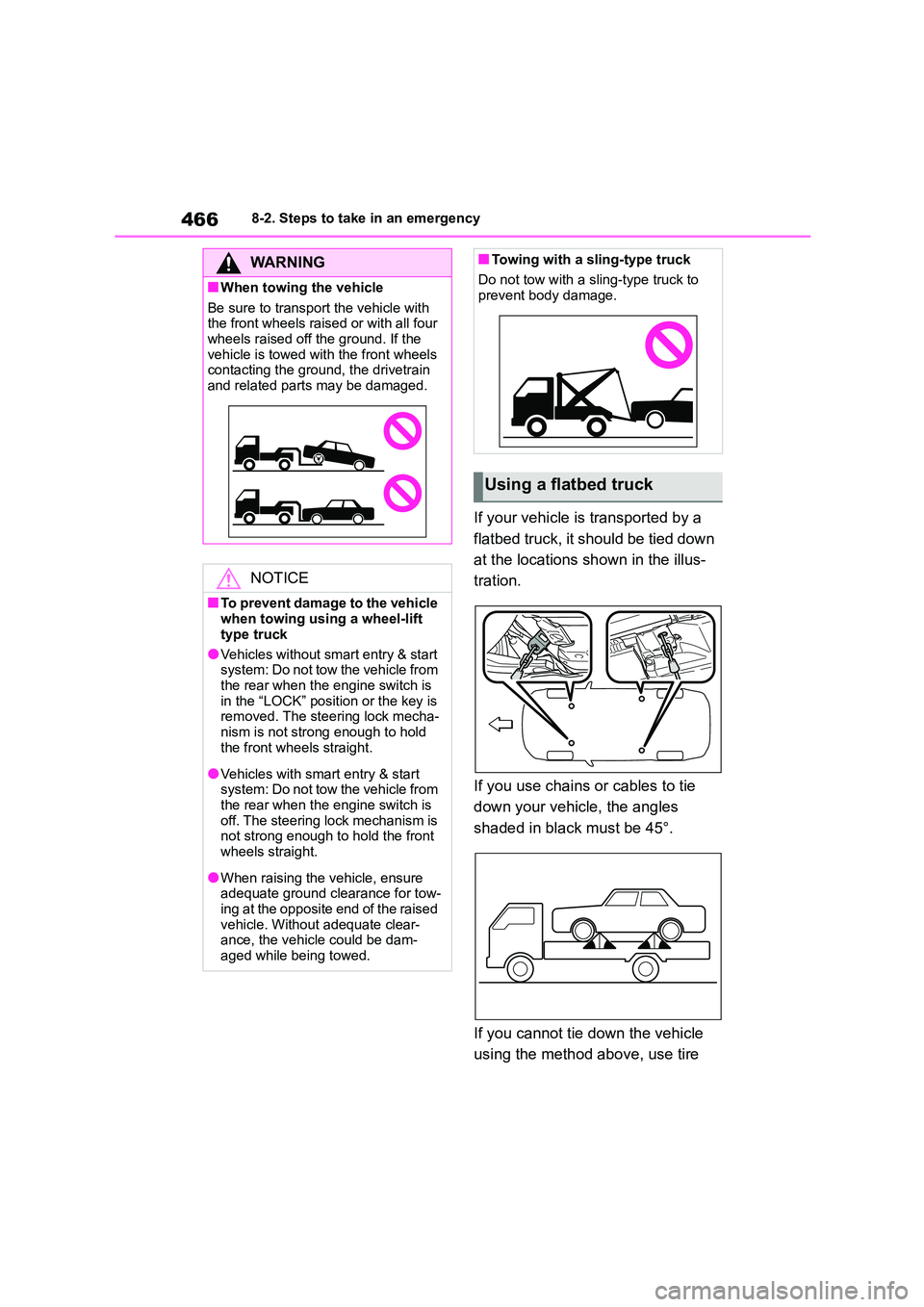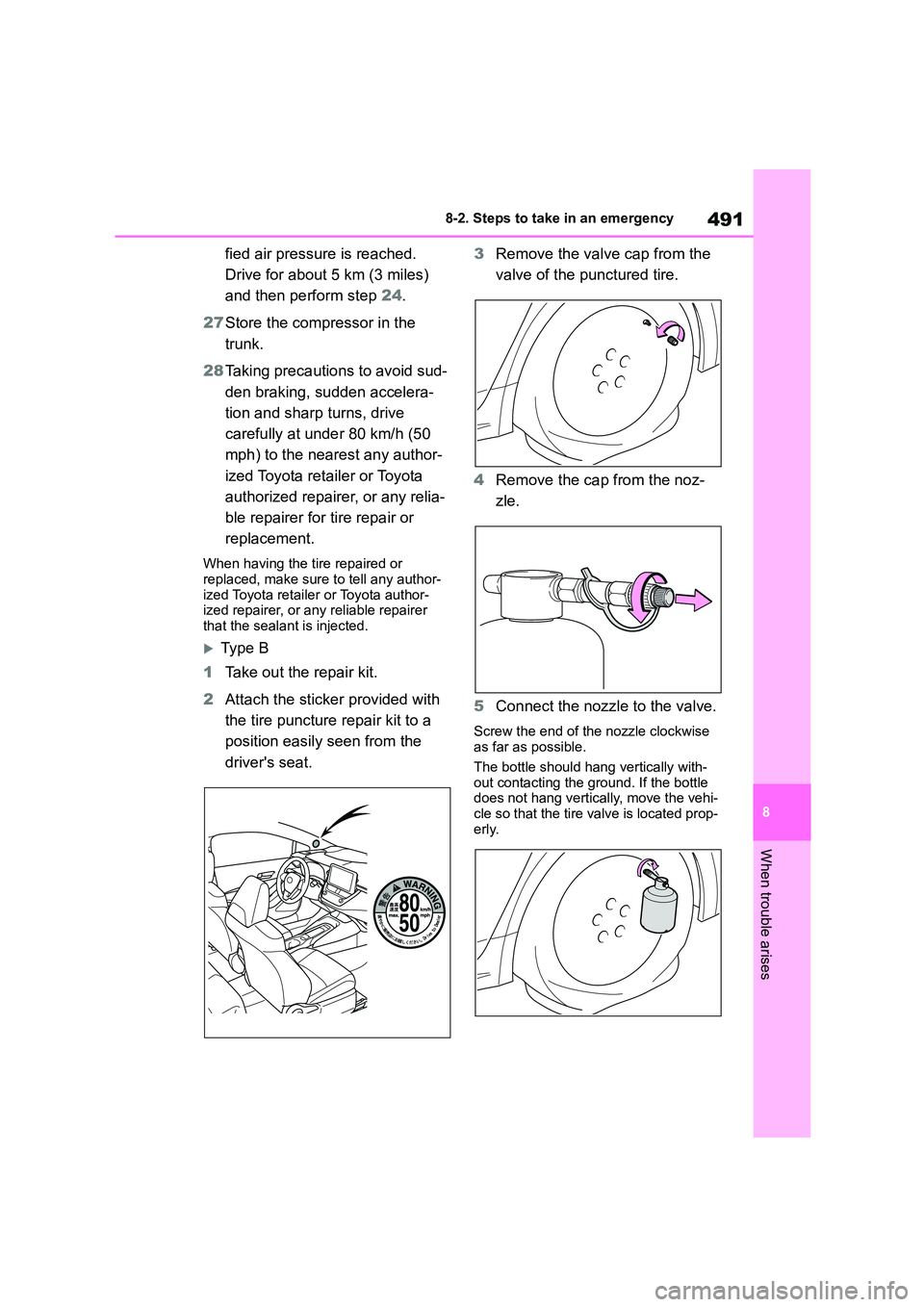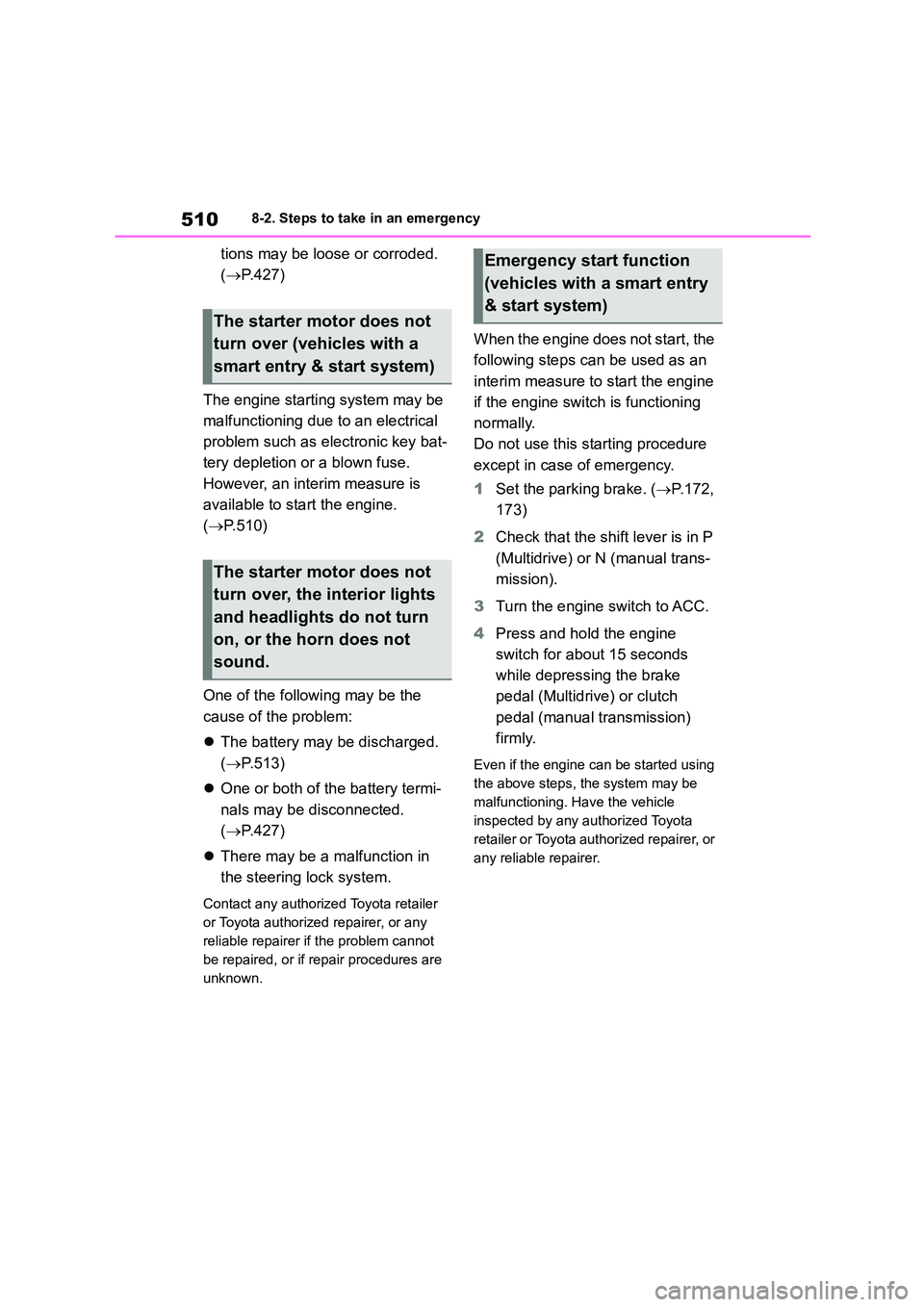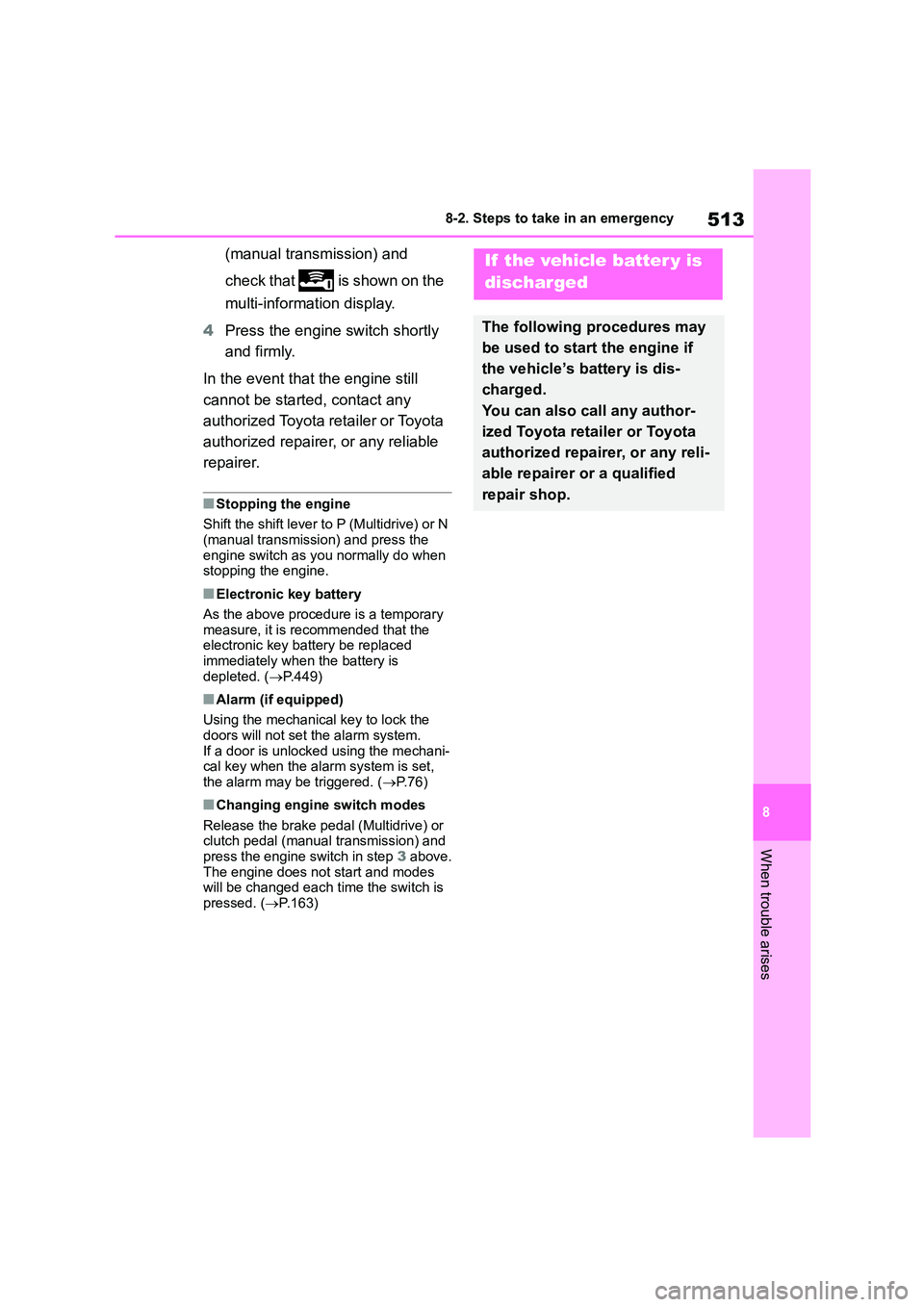Page 468 of 678

4668-2. Steps to take in an emergency
If your vehicle is transported by a
flatbed truck, it should be tied down
at the locations shown in the illus-
tration.
If you use chains or cables to tie
down your vehicle, the angles
shaded in black must be 45°.
If you cannot tie down the vehicle
using the method above, use tire
WA R N I N G
■When towing the vehicle
Be sure to transport the vehicle with
the front wheels raised or with all four wheels raised off the ground. If the
vehicle is towed with the front wheels
contacting the ground, the drivetrain and related parts may be damaged.
NOTICE
■To prevent damage to the vehicle
when towing using a wheel-lift
type truck
●Vehicles without smart entry & start
system: Do not tow the vehicle from
the rear when the engine switch is in the “LOCK” position or the key is
removed. The steering lock mecha-
nism is not strong enough to hold
the front wheels straight.
●Vehicles with smart entry & start
system: Do not tow the vehicle from the rear when the engine switch is
off. The steering lock mechanism is
not strong enough to hold the front wheels straight.
●When raising the vehicle, ensure adequate ground clearance for tow-
ing at the opposite end of the raised
vehicle. Without adequate clear- ance, the vehicle could be dam-
aged while being towed.
■Towing with a sling-type truck
Do not tow with a sling-type truck to
prevent body damage.
Using a flatbed truck
Page 470 of 678

4688-2. Steps to take in an emergency
5Securely attach cables or chains
to the towing eyelet.
Take care not to damage the vehicle
body.
6 Enter the vehicle being towed
and start the engine.
If the engine does not start, turn the
engine switch to ON.
7 Shift the shift lever to N and
release the parking brake.
Vehicles with electric parking brake:
Turn automatic mode off. P. 1 7 4
When the shift lever cannot be shifted
(vehicles with a Multidrive): P. 1 6 6
■While towing
If the engine is not running, the power
assist for the brakes and steering will
not function, making steering and brak- ing more difficult.
■Wheel nut wrench
Vehicles with wheel nut wrench: Wheel
nut wrench is installed in trunk. ( P.482, 498)
WA R N I N G
Observe the following precautions.
Failure to do so may result in death or
serious injury.
■While towing
●When towing using cables or chains, avoid sudden starts, etc.
which place excessive stress on the
towing eyelets, cables or chains. The towing eyelets, cables or
chains may become damaged, bro-
ken debris may hit people, and cause serious damage.
●Vehicles without smart entry & start system: Do not tu rn the engine
switch to the “LOCK” position.
There is a possibility that the steer-
ing wheel is locked and cannot be operated.
●Vehicles with smart entry & start system: Do not turn the engine
switch off.
There is a possibility that the steer- ing wheel is locked and cannot be
operated.
■Installing towing eyelets to the
vehicle
Make sure that towing eyelets are installed securely.
If not securely installed, towing eye-
lets may come loose during towing.
NOTICE
■To prevent damage to the vehicle during emergency towing
Do not secure cables or chains to the
suspension components.
Page 489 of 678
487
8
8-2. Steps to take in an emergency
When trouble arises
4 Remove the cap from the noz-
zle.
5 Connect the nozzle to the valve.
Screw the end of the nozzle clockwise as far as possible.
The bottle should hang vertically with-
out contacting the ground. If the bottle does not hang vertically, move the vehi-
cle so that the tire valve is located prop-
erly.
6 Remove the cap from the bottle.
7 Pull the hose out from the com-
pressor.
8 Connect the bottle to the com-
pressor.
Screw the end of the nozzle clockwise as far as possible.
9 Make sure that the compressor
switch is off.
Page 493 of 678

491
8
8-2. Steps to take in an emergency
When trouble arises
fied air pressure is reached.
Drive for about 5 km (3 miles)
and then perform step 24.
27 Store the compressor in the
trunk.
28 Taking precautions to avoid sud-
den braking, sudden accelera-
tion and sharp turns, drive
carefully at under 80 km/h (50
mph) to the nearest any author-
ized Toyota reta iler or Toyota
authorized repairer, or any relia-
ble repairer for tire repair or
replacement.
When having the tire repaired or
replaced, make sure to tell any author-
ized Toyota retailer or Toyota author- ized repairer, or any reliable repairer
that the sealant is injected.
Type B
1 Take out the repair kit.
2 Attach the sticker provided with
the tire puncture repair kit to a
position easily seen from the
driver's seat.
3 Remove the valve cap from the
valve of the punctured tire.
4 Remove the cap from the noz-
zle.
5 Connect the nozzle to the valve.
Screw the end of the nozzle clockwise
as far as possible.
The bottle should hang vertically with- out contacting the ground. If the bottle
does not hang vertically, move the vehi-
cle so that the tire valve is located prop- erly.
Page 494 of 678
4928-2. Steps to take in an emergency
6Remove the cap from the bottle.
7 Pull the hose out from the com-
pressor.
8 Connect the bottle to the com-
pressor.
Screw the end of the nozzle clockwise
as far as possible.
9 Make sure that the compressor
switch is (off).
10 Remove the power plug from
the compressor.
11 Connect the power plug to the
power outlet socket. ( P.401)
12 Check the specified tire inflation
pressure.
Tire inflation pressure is specified on
the label as shown. ( P.533)
Page 512 of 678

5108-2. Steps to take in an emergency
tions may be loose or corroded.
( P.427)
The engine starting system may be
malfunctioning due to an electrical
problem such as electronic key bat-
tery depletion or a blown fuse.
However, an interim measure is
available to start the engine.
( P.510)
One of the following may be the
cause of the problem:
The battery may be discharged.
( P.513)
One or both of the battery termi-
nals may be disconnected.
( P.427)
There may be a malfunction in
the steering lock system.
Contact any authorized Toyota retailer
or Toyota authorized repairer, or any
reliable repairer if the problem cannot
be repaired, or if repair procedures are
unknown.
When the engine does not start, the
following steps can be used as an
interim measure to start the engine
if the engine switch is functioning
normally.
Do not use this starting procedure
except in case of emergency.
1 Set the parking brake. (P.172,
173)
2 Check that the shift lever is in P
(Multidrive) or N (manual trans-
mission).
3 Turn the engine switch to ACC.
4 Press and hold the engine
switch for about 15 seconds
while depressing the brake
pedal (Multidrive) or clutch
pedal (manual transmission)
firmly.
Even if the engine can be started using
the above steps, the system may be
malfunctioning. Have the vehicle
inspected by any authorized Toyota
retailer or Toyota authorized repairer, or
any reliable repairer.
The starter motor does not
turn over (vehicles with a
smart entry & start system)
The starter motor does not
turn over, the interior lights
and headlights do not turn
on, or the horn does not
sound.
Emergency start function
(vehicles with a smart entry
& start system)
Page 514 of 678

5128-2. Steps to take in an emergency
Use the mechanical key (P. 111 )
in order to perform the following
operations:
1 Locks all the doors
2 Unlocks all the doors
■Key linked functions
1 Closes the windows and moon
roof*1 (turn and hold)*2
2 Opens the windows and moon
roof*1 (turn and hold)*2
*1: If equipped
*2: These settings must be customized
at any authorized Toyota retailer or
Toyota authorized repairer, or any
reliable repairer.
1 Vehicles with a Multidrive:
Ensure that the shift lever is in P
and depress the brake pedal.
Vehicles with a manual trans-
mission: Shift the shift lever to N
and depress the clutch pedal.
2 Touch the Toyota emblem side
of the electronic key to the
engine switch.
When the electronic key is detected, a
buzzer sounds and the engine switch will turn to ON.
When the smart entry & start system is
deactivated in customization setting, the engine switch will turn to ACC.
3 Firmly depress the brake pedal
(Multidrive) or clutch pedal
Locking and unlocking the
doors
WA R N I N G
■When using the mechanical key
and operating the power win-
dows or moon roof (if equipped)
Operate the power window or moon
roof after checking to make sure that
there is no possibility of any passen- ger having any of their body parts
caught in the window or moon roof.
Also, do not allow children to operate
the mechanical key. It is possible for children and other passengers to get
caught in the power window or moon
roof.
Starting the engine
Page 515 of 678

513
8
8-2. Steps to take in an emergency
When trouble arises
(manual transmission) and
check that is shown on the
multi-information display.
4 Press the engine switch shortly
and firmly.
In the event that the engine still
cannot be started, contact any
authorized Toyota retailer or Toyota
authorized repairer, or any reliable
repairer.
■Stopping the engine
Shift the shift lever to P (Multidrive) or N
(manual transmission) and press the
engine switch as you normally do when stopping the engine.
■Electronic key battery
As the above procedure is a temporary
measure, it is recommended that the electronic key battery be replaced
immediately when the battery is
depleted. ( P.449)
■Alarm (if equipped)
Using the mechanical key to lock the
doors will not set the alarm system.
If a door is unlocked using the mechani-
cal key when the alarm system is set, the alarm may be triggered. ( P.76)
■Changing engine switch modes
Release the brake pedal (Multidrive) or
clutch pedal (manual transmission) and press the engine switch in step 3 above.
The engine does not start and modes
will be changed each time the switch is pressed. ( P.163)
If the vehicle batter y is
discharged
The following procedures may
be used to start the engine if
the vehicle’s battery is dis-
charged.
You can also call any author-
ized Toyota retailer or Toyota
authorized repairer, or any reli-
able repairer or a qualified
repair shop.